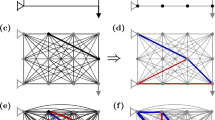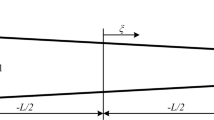Abstract
The design obtained from a topology optimization problem can be sensitive to the type and details of the ground structure used. A new type of ground structure containing hinged beam elements is described that increases the types of elements in the ground structure available to the optimizer. In addition to the pin-ended truss and rigidly-connected beam elements that have traditionally been used, two new types of elements are introduced: (1) a beam with a hinge on one end and a solid connection on the other end, (2) a beam with hinges on both ends. These elements have different deflection characteristics than those of the typical truss or beam elements, and can be used in ground structure-based compliant mechanism design. Given a reduced ground structure, these new elements effectively increase the design space. Pin-ended members with lengths larger than those of the ground structure cell size are permitted to develop, reducing the sensitivity of solutions to the cell density of the reduced ground structure. Furthermore, because these longer members do not require intermediate lateral support to provide stability, as series connections of shorter pin-ended members do, fewer ancillary members are required. Two compliant mechanism problems are solved to demonstrate the effectiveness of these new elements.
Similar content being viewed by others
References
Achtziger W, Stolpe M (2007) Truss topology optimization with discrete design variables—guaranteed global optimality and benchmark examples. Struct Multidisc Optim 34:1–20
Ananthasuresh GK, Frecker M (2001) Optimal synthesis with continuum models, in compliant mechanisms. Wiley
Bendsoe MP, Sigmund O (2003) Topology optimization: theory, methods and applications. Springer, Berlin
Bharti S, Frecker M, Lesieutre G (2006) A methodology for optimal structural design of a morphing aircraft wing using non-dominated sorting genetic algorithm II. In: SPIE 13th international symposium on smart structures and materials. San Diego, CA
Buhl T, Pederson C, Sigmund O (2000) Stiffness design of geometrically nonlinear structures using topology optimization. Struct Multidisc Optim 19(2):93–104
Canfield S, Frecker M (2000) Topology optimization of compliant mechanical amplifiers for piezoelectric actuators. Struct Multidisc Optim 20(4):269–278
Frecker M, Ananthasuresh GK, Nishiwaki S, Kikuchi N, Kota S (1997) Topological synthesis of compliant mechanisms using multi-criteria optimization. J Mech Des Trans ASME 119(2):238–245
Giger M, Ermanni P (2008) Evolutionary truss topology optimization using a graph-based parameterization concept. Struct Multidisc Optim 32:313–326
Guo X, Cheng GD, Olhoff N (2005) Optimum design of truss topology under buckling constraints. Struct Multidisc Optim 30:169–180
Hetrick JA, Kota S (1999) An energy formulation for parametric size and shape optimization of compliant mechanisms. ASME J Mech Des 121:229–234
Joo J, Kota S, Kikuchi N (2000) Topological synthesis of compliant mechanisms using linear beam elements. Mechan Struct Mach 28(4):245–280
Kawamoto A, Bendsoe MP, Sigmund O (2004) Articulated mechanism design with a degree of freedom constraint. Int J Numer Methods Eng 2004(61):1520–1545
Lyu N, Saitou K (2005) Topology optimization of multicomponent beam structure via decomposition-based assembly synthesis. ASME J Mech Des 27:170–183
Ramrakhyani D, Lesieutre G, Bharti S, Frecker M (2005a) Aircraft structural morphing using tendon actuated compliant cellular trusses. J Aircr 42(6):1615–1621
Ramrakhyani D, Frecker M, Lesieutre G, Bharti S (2005b) Parallel genetic algorithm for design of morphing cellular truss structures. In: ASME international mechanical engineering congress and exposition. Orlando, FL
Sauter M, Kress G, Giger M, Ermanni P (2008) Complex-shaped beam element and graph-based optimization of compliant mechanisms. Struct Multidisc Optim (online first)
Saxena A (2005) Topology design of large displacement compliant mechanisms with multiple materials and multiple output ports. Struct Multidisc Optim 30(6):477–490
Saxena A, Ananthasuresh G (2000) On an optimal property of compliant topologies. Struct Multidiscipl Optim 19(1):36–49
Sigmund O (1996) Tailoring materials with prescribed elastic properties. Mech Mater 20(4):351–368
Author information
Authors and Affiliations
Corresponding author
Rights and permissions
About this article
Cite this article
Ramrakhyani, D.S., Frecker, M.I. & Lesieutre, G.A. Hinged beam elements for the topology design of compliant mechanisms using the ground structure approach. Struct Multidisc Optim 37, 557–567 (2009). https://doi.org/10.1007/s00158-008-0262-3
Received:
Revised:
Accepted:
Published:
Issue Date:
DOI: https://doi.org/10.1007/s00158-008-0262-3




